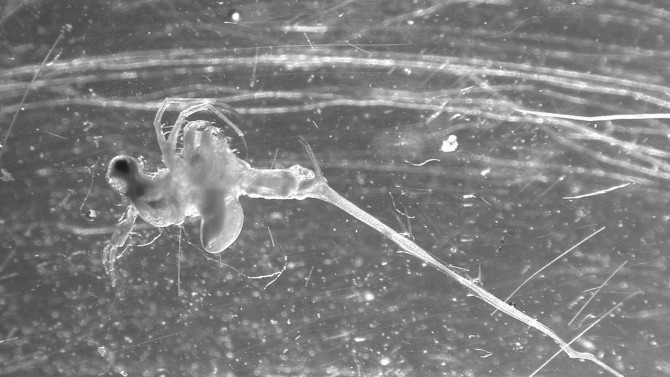Cornell student finds invasive water flea in Oneida Lake
By Blaine Friedlander
The spiny water flea – a nasty, predatory and invasive zooplankton species – was discovered Sept. 16 in Oneida Lake by a Cornell student at the Cornell Biological Field Station at Shackelton Point in Bridgeport, New York.
Known to wreak havoc on the aquatic food chain, the flea was discovered by Josh Appel ’22 during routine work in Natural Resources 2100, a field biology class.
Groups of students from the class, taught by senior lecturer Paul Rodewald and research associate Marc Goebel, had collected water samples from Oneida Lake and brought them back to the field station’s lab for analysis, according to Appel.
Soon after, Appel began helping research support specialist Kristen Holeck to prepare the samples.
“While looking in the petri dish, I saw what looked like a tiny clear shrimp and I had no clue what it was,” Appel said. “[Kristen] told me that it was an invasive spiny water flea. Soon after, we found more swimming around in our samples.”
Lars Rudstam, professor of natural resources and director of the Cornell Biological Field Station, said that the spiny water flea (Bythotrephes longimanus) could affect the lake’s ecosystem, which Cornell researchers will continue to monitor. Rudstam reported the discovery to the New York State Department of Environmental Conservation.
In follow-up sampling, Cornell biologists on Oneida Lake detected the spiny water flea at densities of 20 to 140 per cubic meter, a density comparable to samples found in Lake Erie and Lake Ontario.
Feeding on smaller zooplankton in lakes, the spiny water flea is about a half-inch long, and its tailspine deters predators. Lake fish consume this animal; in mid-September, Cornell biologists caught young yellow perch (2.5 inches long), young white perch and emerald shiners and noted that the fish all had consumed the spiny water fleas.
This zooplankton was first found in Lake Ontario in 1982 and spread to all the Great Lakes and many surrounding smaller lakes in Canada, Michigan, Minnesota and Wisconsin within a decade, Rudstam said.
The spiny water flea was found in the Great Sacandaga Lake (northern Fulton and Saratoga counties, in the Adirondacks) in 2008, Lake George in 2012 and Lake Champlain in 2014.
This species is known as a food web disruptor in the Great Lakes system because of its ability to decrease the abundance of other zooplankton, an important food source for fish, Rudstam said. A dietary shift in young fish could cause a decline in their growth rates.
Because invasive species can travel on boats and fishing gear, “Be vigilant when moving equipment and boats across systems,” Rudstam said. “Boaters should be sure to drain all water holding compartments before leaving a water body. The likelihood that the species will continue to spread to the New York’s Finger Lakes is now high.”
Media Contact
Get Cornell news delivered right to your inbox.
Subscribe


